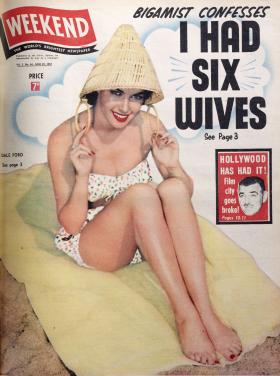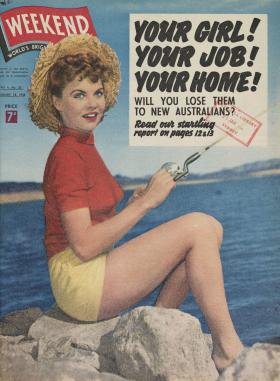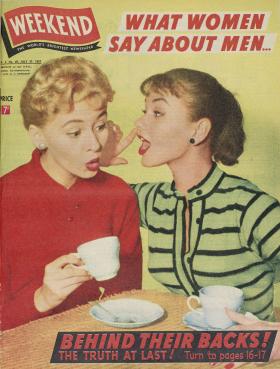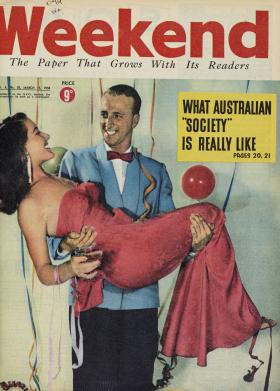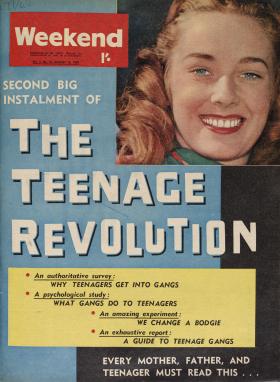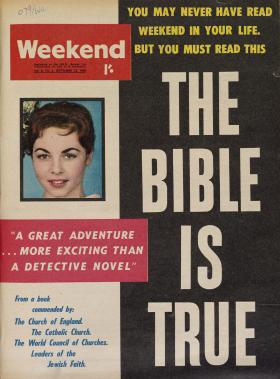The new weekly magazine Weekend hit newsstands in August 1954 intent on making a splash. Declaring itself ‘Australia’s Brightest Newspaper!’, it set out to exploit loosening social and cultural constraints and a growing public appetite for light-hearted commuter fodder. It filled its pages with schoolyard jokes, lively yarns and large provocative images. The first issue featured a swimsuit-clad blonde (‘the sweetest Swede we’ve ever come across’) reclining across the front page, surrounded by outlandish headlines: ‘I Married the World’s Strongest Woman’, ‘Bushranger Cut Off their Heads’.
Weekend was one of a glut of new titles created or acquired by Frank Packer’s Consolidated Press during the 1950s. Packer was the owner of Sydney’s Daily Telegraph and the popular Australian Women’s Weekly. In 1954 he decided to bring out a new publication modelled on the British weekly Reveille. The British magazine, which had featured the American model Marilyn Monroe earlier in the year, was thought to be planning an Australian edition. Packer, in typical style, conspired with another UK magazine, the Weekly Mail, to create a jointly owned company called Weekend Pty Ltd and beat Reveille to the punch.
For an editor he turned to a 32-year-old London-based Australian named Donald Horne. At the time, Horne was a reporter in the Consolidated Press Fleet Street bureau who had designs on a Conservative Party seat in the House of Commons. He was a product of Sydney University and had worked on and off for Packer since the early 1940s, often under legendary editors like Brian Penton and Cyril Pearl. But Horne was not initially enthusiastic about the prospect of editing Weekend. He had a sharp mind and feared that the move back to Australia would derail his desire to write novels.
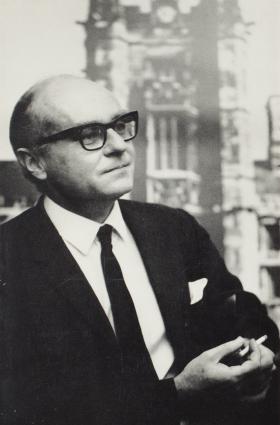
Reluctantly, Horne took the job. He never did become a serious novelist, but neither is his name commonly associated with Weekend’s brand of sensationalist ephemera. He is best known as the author of The Lucky Country, a wildly popular critique of Australia in the 1960s. He eventually wrote over 30 books and became a prominent social critic and public figure in his own right. Horne’s papers, held at the Mitchell Library, are a rich resource for historians of twentieth century Australia.
As Weekend’s editor, Horne was fearsome and intimidating. He had a reputation for hiring and firing spontaneously and demanded perfection from his staff. He frequently ridiculed sub-editors in front of the entire office and would theatrically throw bad copy out the window if it failed to meet his high standards. At one point he circulated a memo warning his staff that dismissal would follow any ‘failure to act like grown up journalists’.
Under Horne’s command, Weekend became a success. He positioned it as a breezy alternative to the more staid offerings at 1950s Australian newsagents. In doing so he tested the boundaries of propriety: the furthest allowable depth of a woman’s cleavage, for example, became a matter of weekly debate among the staff. The art critic Robert Hughes memorably dismissed Weekend as a ‘Packer tit-and-bum sheet’. Horne preferred ‘extreme lowbrow general magazine’.
Despite its ‘sexy’ reputation, Weekend was produced by an industrious and talented staff. Its most famous alumnus was Lillian Roxon, the Rolling Stone journalist and author of the Rock Encyclopaedia. Horne’s thorough editing standards also belied the magazine’s overt silliness. Every aspect of Weekend’s content and appearance was planned and overseen in forensic detail. Horne produced long bulletins for his staff with pithy instructions on each element of the magazine’s production, from font size to the choice and placement of pictures (‘No picture must be used unless it is interesting in itself’) to the appropriate way to structure a recipe (‘Do not assume that readers know many cooking terms’).
Read together, Horne’s editorial notes are like an instruction manual for mass-market magazine editing. One memo — titled ‘Diagnosis and Cure’ — listed 12 general problems with Weekend’s content and appearance and the 12 associated solutions. Another described the ideal weekly schedule (‘Monday is ideas day’, ‘Tuesday is planning day’). In one unforgettable note, he produced an ‘ingredients’ list of what made a good issue of Weekend. This included ‘high class disconnected chatter’, ‘a stunt story’, ‘girls’ and ‘a warm-hearted, perhaps sad story, detailing one of life’s tragedies and, if possible, how it has been cheerfully overcome’.
Predictably, the magazine’s provocative content attracted some powerful enemies. Weekend’s first big nemesis was the Queensland Literature Review Board, which banned it from publication in Queensland in April 1956 because it ‘unduly emphasised sex’, though Weekend Pty Ltd managed to convince the board to lift the ban two weeks later. The board’s list of objectionable Weekend headlines had included ‘I Love to Strip’, ‘Pyjama Party! Amazing Pictures’ and ‘Love Life of a Milko’. A little over 12 months later, the board reinstated the ban, alleging that ‘a culturally sick and weak community is in no position to withstand assaults upon its cultural standards’.
At the same time, Weekend and its main rival, Crowd, came under fire from the Catholic Church. Melbourne Archbishop Daniel Mannix called Weekend a ‘disgrace to Australia’, while the Catholic newspaper Advocate led with the headline ‘Sexy Publications Corrupting Australia’s Youth’. The Church’s Council for the Promotion of Cultural Standards labelled Weekend and Crowd ‘impure publications’ that ‘bred effeminate boys and masculine girls’. Worse still, a prominent church figure was quoted urging ‘every Catholic’ to ‘support a campaign against the corrupting influence of these two publications’.
Horne campaigned hard for a retraction of the comments, and after a month of furious correspondence the church finally relented. The Queensland censorship issue, however, required a flexing of Packer muscle. The prominent lawyer Sir Garfield Barwick was brought in when the case went all the way to the Queensland Supreme Court. At one point, the litigants engaged in a farcical courtroom debate about whether a ‘slight discolouration’ in a Weekend image represented the ‘faint suggestion of a nipple’. Weekend Pty Ltd eventually secured an injunction against the ban, and the ‘anecdote of the extra nipple’ became a Horne favourite.
Only those with long memories will recall Horne’s time as editor of Weekend, though it was a formative period of his intellectual life. As a minor executive, he learned to navigate the secretive politics of the Packer media empire. He came to see buccaneering entrepreneurs, management styles and office hierarchies as sources of intellectual curiosity. Crucially, he developed a mind for marketing: Weekend had a circulation of over 400,000 and the priority was always to find ways to increase the size and loyalty of this readership. Magazines, he told his staff, existed on two levels: the ‘superficial’ level (‘the person who skims and does nothing else’) and the ‘deeper’ level (‘the person who wants to settle down to a good read’). Weekend had to be both.
Horne gradually lost interest in Weekend, especially after the launch of the intellectual fortnightly Observer, and later the takeover of the Bulletin, both of which he also edited. In 1961, amid falling sales, the magazine was merged with Packer’s newly acquired Australian Woman’s Mirror and renamed Everybody’s. The new magazine laboured along until 1968, but Horne’s involvement ended in 1962 when he left for a job in advertising. Though his time at Weekend appears to be out of sync with his future career, it honed his talent for salesmanship and simple prose. In later life, these skills helped transform Donald Horne from the author of a popular book into one of Australia’s most recognisable intellectuals.
Writer and historian Ryan Cropp is completing a PhD at the University of Sydney on the life of Donald Horne.

